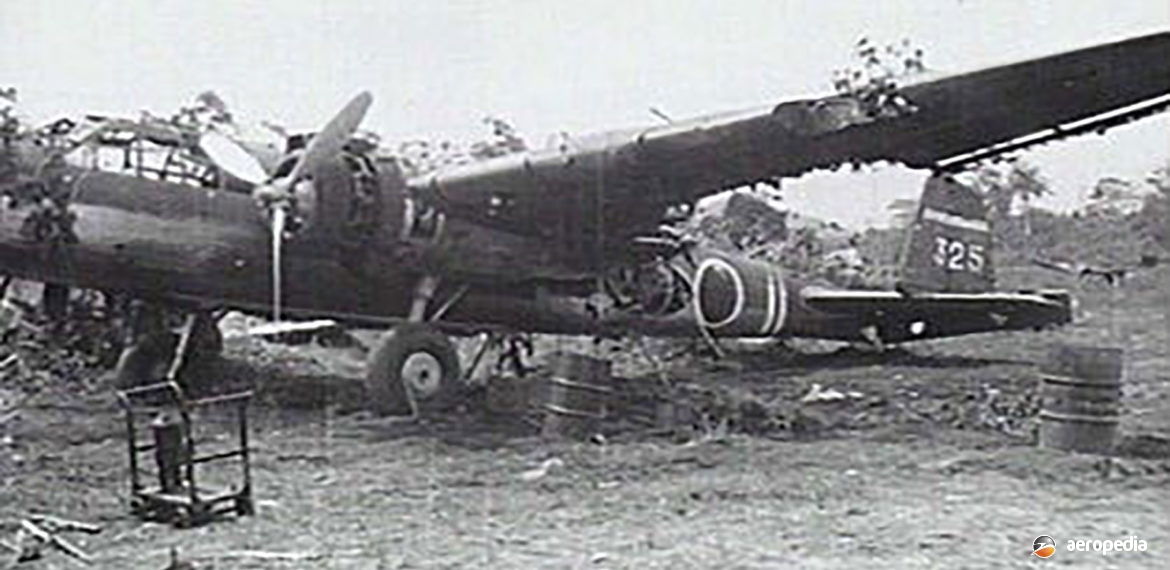Photograph:
A Mitsubishi G3M ‘Nell’ late in World War II (Author’s collection)
Country of origin:
Japan
Description:
Long-range land-based bomber
Power Plant:
Two 802 kw (1,075 hp) Mitsubishi Kinsei 45 fourteen-cylinder two-row air-cooled radial engines
Specifications:
- Wingspan: 25 m (82 ft 0¼ in)
- Length: 16.45 m (53 ft 11⅝ in)
- Height: 3.68 m (12 ft 1⅛ in)
- Wing area: 75.0 m² (807.3 sq ft)
- Max speed at 4,180 m (13,715 ft): 373 km/h (232 mph)
- Cruising speed at 4,000 m (13,125 ft): 278 km/h (173 mph)
- Climb to 3,000 m (9,842 ft): 8 mins 19 secs
- Service ceiling: 9,130 m (29,950 ft)
- Range: 4,381 km (2,722 miles)
- Empty weight: 4,965 kg (10,936 lb)
- Loaded weight: 8,000 kg (17,637 lb)
Armament:
One rear upper turret with one 20 mm Type 99 Model 1 cannon; one small upper front turret with one 7.7 mm (0.303 in) machine gun; two blister type turrets at wing trailing edge each housing one flexible 7.7 mm (0.303 in) machine gun; normal bomb load 800 kg (1,764 lb)
History:
Designed by Sueo Honjo, and produced by Mitsubishi Jukogyo K K, the prototype G3M ‘Nell’ powered by two 448 kw (600 hp) Hiro Type 91 liquid-cooled engines was flown in April 1935 and attained a maximum speed of 314 km/h (195 mph). Three further prototypes were built with the Hiro engine, but thereafter the 615 kw (825 hp) Mitsubishi Kinsei Model 2 radial engine was installed. Subsequently the type entered production as the G3M1 (Type 96 Land-Based Attack Bomber).
After 22 aircraft had been completed, production changed to the G3M1c with 627 kw (840 hp) Kinsei Model 3 engines. A number were converted on the production line to ten-seat high-speed transports, known as the L3Y1. From the 56th production aircraft the type was fitted with 746 kw (1,000 hp) Kinsei 45 radial engines and became the G3M2, and this variant was produced in substantial numbers. The G3M2 had various equipment changes, including a new dorsal turret, and the fuel capacity was increased to 3,874 litres (852 Imp gals). A total of 343 G3M2 Model 21s was built at Mitsubishi’s Nagoya plant.
A number of “flag waving” flights to foreign capitals were made by civil variants, include Soyokaze (J-BEOA) to Teheran, Persia (later Iran) in 1939; Yamato (G-BEOC) to Rome, Italy in April 1937; Kamikaze (J-BAAI) from Tokyo to London, UK; and Nippon (J-BACI) to Canada and the United States.
Initial operations with the type commenced on 14 August 1937 when G3Ms left Taipei on the island of Formosa and carried out surprise attacks on the Chinese cities of Hangkow and Kwangteh. The outset of the Pacific war saw the ‘Nell’, as it was known by the Allies, as the major type in terms of numbers in Japanese Army service. It remained in service until the collapse of Japan, and the type is best known for its involvement in the sinking of the British Battleships HMS Prince of Wales and HMS Repulse off the coast of Malaya on 12 December 1941. By the time production ceased some 1,048 examples had been completed by Mitsubishi, Nakajima and the Hiro Navy Arsenal.
On 19 February 1942 a force of 54 land-based bombers, including 27 G4M1 Betty’s of the Tokao Kokotai, 23rd Koki Sentai based at Kendasi in the Celebes and 27 G3M1 ‘Nells’ of the Tokao Ku based at Ambon, attacked Darwin, NT, the ‘Nells’ being tasked with neutralising the airfields and aircraft in the Darwin area. The defence of Darwin was carried out by ten Curtiss P-40s of the 33rd Squadron, USAAF.
Records as to Japanese G3M losses at this time are not available but it is assumed the type was also used alongside Mitsubishi G4M ‘Bettys’ on other bombing missions of Australia during that period and examples of the type were shot down by opposing fighters. On 11 March 1942 Horn Island was attacked by eight ‘Nells’ with nine ‘Zeros’ in support. No 24 Squadron with Wirraways, and nine Kittyhawks of No 49 Fighter Group, USAAC, intercepted the Japanese force and two ‘Zeros’ and one ‘Nell’ were shot down. In 1944 a captured ‘Nell’ was recovered from Lae by No 2 ASS and shipped to the United States for testing but does not seem to have survived.

